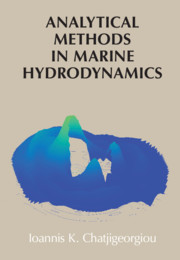Book contents
- Analytical Methods in Marine Hydrodynamics
- Dedication
- Analytical Methods in Marine Hydrodynamics
- Copyright page
- Contents
- Foreword
- Preface
- Note on Symbols and Notations
- 1 Description of the Flow
- 2 Linear Hydrodynamics of Circular Cylinders
- 3 Higher-Order Phenomena for Circular Cylinders
- 4 Hydrodynamics of Elliptical Cylinders
- 5 Hydrodynamics of Spheres and Spheroids
- 6 Hydrodynamics of Ellipsoids
- Book part
- References
- Index
3 - Higher-Order Phenomena for Circular Cylinders
Published online by Cambridge University Press: 27 June 2018
- Analytical Methods in Marine Hydrodynamics
- Dedication
- Analytical Methods in Marine Hydrodynamics
- Copyright page
- Contents
- Foreword
- Preface
- Note on Symbols and Notations
- 1 Description of the Flow
- 2 Linear Hydrodynamics of Circular Cylinders
- 3 Higher-Order Phenomena for Circular Cylinders
- 4 Hydrodynamics of Elliptical Cylinders
- 5 Hydrodynamics of Spheres and Spheroids
- 6 Hydrodynamics of Ellipsoids
- Book part
- References
- Index
Summary
Why do moored ships perform large-amplitude slow-varying oscillatory motions? Why do they oscillate around a displaced mean position different than the fundamental rest position that assumes no environmental action? Why are tension-leg platforms subjected to fast oscillatory behavior at high frequencies? Why is the wave run-up on the buoyancy members of those types of structures so strong, in fact stronger than that anticipated from the linear theory? Why may the air-gap between the free surface and the underneath area of the deck be reduced, leading to violent “hummer” hitting by the free surface, often called “slamming”?
These questions arise from physical observations and evidently they are related to the equivalent oscillator that resembles the vessel’s oscillatory behavior. Water waves induce cyclic loading and accordingly cycling motions on floating structures. Whether those structures will oscillate depends on their restoring characteristics. To create an equivalent oscillator we must put restoring, i.e., equivalent springs, represented by restoring coefficients. Ships and floating vessels, by design, have their own restoring characteristics that they are made to have. In order to claim their mean position under external excitation and secure their intact stability. However, again by design, they don’t incorporate restoring in surge, sway, and yaw, namely the modes of motion on the plane of the free surface. When restoring is needed in relevant situations, this is achieved technically, e.g., by moorings, tendons, etc.
A great challenge in structural dynamics, perhaps the greatest, is the capture of resonance regimes and the anticipation of the resonance behavior of the oscillating structure. Depending on its natural frequencies (eigenfrequencies/eigenperiods), resonances may be linear or nonlinear. A structure subjected to, say, regular waves, behaves as an oscillator responding in “wave frequencies.” Whether those frequencies are indeed resonance frequencies depends on the structural eigenfrequencies. Nonetheless, what we call regular sea waves are not purely harmonic, in the sense that they are not formulated by a single harmonic function. In fact they contain higher-order components (in terms of the fundamental frequency) that arise from the nonlinear free-surface boundary conditions. Hence, given that nonlinear incident (excitation) components may occur, it should be expected that any floating structure may experience nonlinear resonances as well. In addition, real sea states, by definition, are not single-frequency processes. In contrast, they are formulated as an infinite superposition of discrete regular waves. In that respect, the excitation arises not only from the individual constituent frequencies but also from all possible combinations of them, sums and differences, creating an infinite set of possible nonlinear excitations. If a natural frequency of a structure falls into the vicinity of, or coincides with, one or all of these potential nonlinear excitations, then a nonlinear resonance regime is stimulated. Hence, it is of paramount importance to anticipate the associated loading components, exciting forces, and moments that may accordingly lead to resonance behavior. For inviscid, incompressible fluid and irrotational flow, this task falls within the context of nonlinear potential theory, which is the subject of the present chapter.
In this chapter we present the second-order solution methods for hydrodynamical boundary value problems involving circular cylinders. Inevitably, the nonlinear free-surface boundary condition is properly processed to accommodate the second-order quadratic terms. The second-order solutions sought are obtained by means of the Green’s theorem and the governing Green’s functions. Also, solutions are provided for uniform, truncated, and compound cylindrical bodies. The second-order diffraction problem by arrays of multiple circular cylinders is investigated based always on the use of the Green’s theorem and finally the prevailing methods for calculating the mean, second-order drift forces are presented.
- Type
- Chapter
- Information
- Analytical Methods in Marine Hydrodynamics , pp. 96 - 176Publisher: Cambridge University PressPrint publication year: 2018



